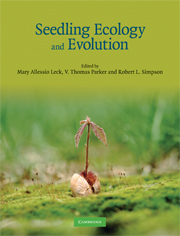Foreword by Peter J. Grubb
Published online by Cambridge University Press: 05 June 2012
Summary
The properties of seedlings are potentially important to all plant ecologists, whether they be interested chiefly in understanding seminatural indigenous vegetation, invasive plants, or the problems of restoration. In seminatural vegetation, seedling properties may determine the climatic regions occupied on a continental scale and the habitats occupied within a landscape, the ability of one species to coexist with another in a community, and the abundance of one species relative to another at a given time and place. The requirements of seedlings often determine the sites in which potentially invasive species can succeed and whether a given approach to restoration of seminatural vegetation is effective.
During the last 40 years, there has been a steady increase in the amount of research by ecologists on the properties of seedlings as opposed to those of mature plants. Great pioneers such as F. E. Clements and E. J. Salisbury appreciated the importance of studying seedlings, although papers on experimental studies on seedlings were uncommon before the 1960s. Several factors have driven the increase in work on seedlings. Here I emphasize seven.
First, there has been a desire to seek generalizations about seed-lings. For example, how does relative growth rate vary with the mass of reserves in the seed, and how does it differ at a given seed-reserve mass between plants of different growth forms (such as tree vs. herb), or species from different kinds of habitat (where the vegetation shows high and low productivity, respectively)?
- Type
- Chapter
- Information
- Seedling Ecology and Evolution , pp. xiii - xviPublisher: Cambridge University PressPrint publication year: 2008



